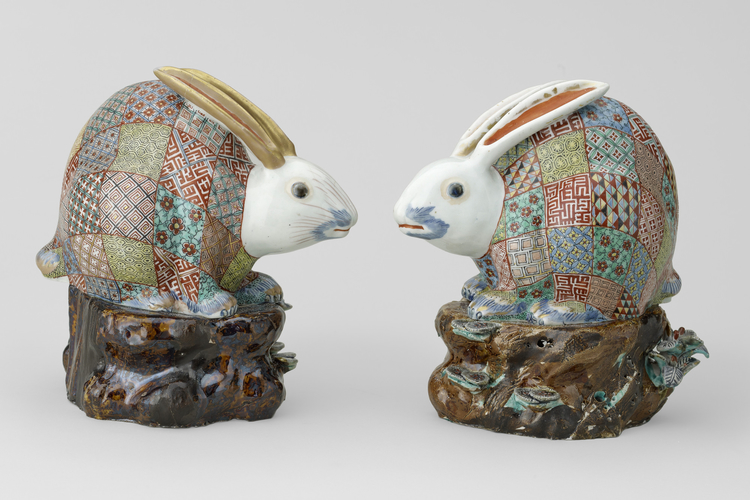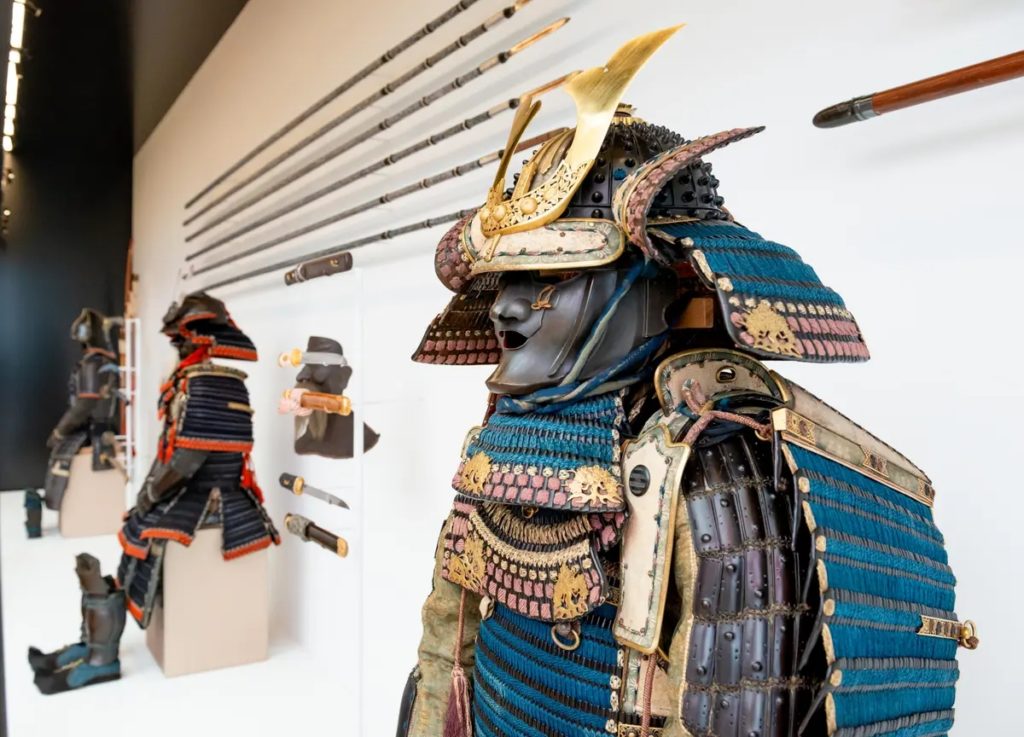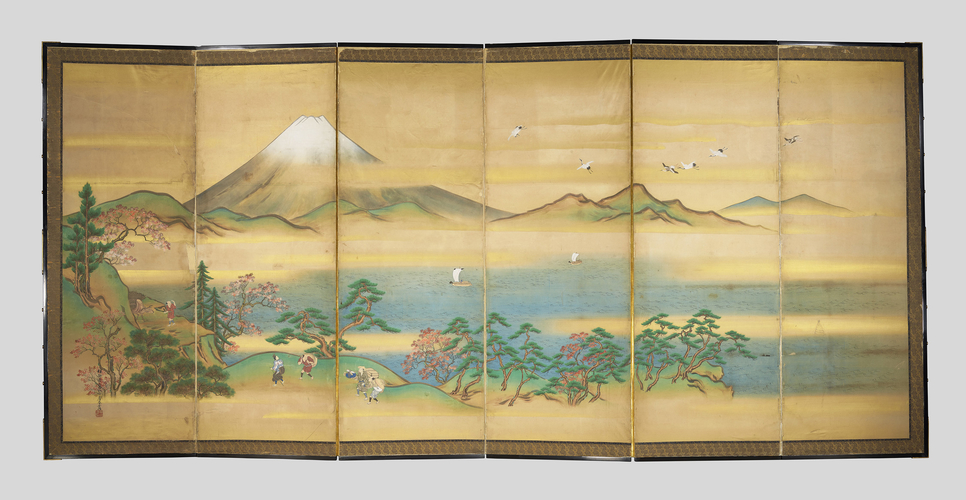Japan: Courts and Culture
April 14, 2022 · 0 comments
By Helen McCarthy.

Japan: Courts and Culture was originally scheduled to open in 2020. Like so many of that year’s best-laid plans, it had to be shelved. But the wait has been worth it. The exhibition is a refined, elegant and entrancing look at a centuries-long relationship between two island empires separated by “ten thousand leagues of clouds and waves” as Tokugawa Ieyasu wrote to James I of England on 4th September 1613.
We have no record of James’s reaction to that letter, or to the gift of two suits of Japanese armour and ten decorated screens that accompanied it. But in curator Rachel Peat’s spacious, serene exhibition, we can see one of those suits of armour, still with its original scarlet and blue lacing, its textile undersleeves supporting beautifully forged mail reinforcements, its magnificent helmet and ferocious facemask fearsome as the day they were forged.
The delight of this exhibition is in its variety, and in the unexpected stories it uncovers. Arranged chronologically, it charts a relationship at first formal, distant in every sense, becoming more tangible and personal as travel and communication speeded up in the later nineteenth and early twentieth century. As the Japanese Imperial Family began to mix with other royal houses around the world on formal visits, the British view of Japan as a mythical landscape populated by arcane creatures began to change. The chronological approach makes the exhibition very accessible, mixing categories together so that those not enamoured of porcelain or swords can move on to other delights. Yet the simple layout and clear explanations keep the story flowing coherently.

There are royal family photos in kimono – Queen Victoria and her offspring loved to cosplay. Victoria’s son Prince Arthur and his family present a Japanese tableau vivant to entertain the other royals holidaying at Osborne in 1891. Two years earlier, the Queen’s eleven-year-old granddaughter Princess Alexandra of Edinburgh larked about in kimono and bloomers in photographer Eduard Uhlenhuth’s studio.
Other royal photos now tell different stories to us than to their own era. In May 1921, Crown Prince Hirohito, later the Showa Emperor, became the first heir to the Japanese throne to visit Britain. He was photographed in white tie and tails with the Prince of Wales, later Edward VIII, at a dinner at St. James’s Palace. The following year, the two Imperial heirs were snapped in natty plus-fours at the Tokyo Golf Club when Edward returned the visit. Four years later Hirohito ascended the Imperial throne for the longest reign in Japanese history. Edward reigned for less than a year in 1936.

There is an impressive parade of formal porcelain, but nobody encountering the enchanting turtle and hare incense burners on display here could consider all porcelain formal. In the 17th and 18th centuries it was all the rage. While Japan was closed to Western nations, the Dutch trading post at Dejima island, Nagasaki enabled rich European tastemakers like Mary II of England to acquire vast quantities of Japanese porcelain. Mary displayed much of her collection at Hampton Court palace, and one particular style of six-sided lidded vase was so admired that European porcelain factories churned out copies known as “Hampton Court jars.”
The lacquer boxes and bowls dazzle as expected, an endlessly glowing array of gold, but the mind boggles at exactly how anyone would drink from the twenty-inch-wide ceremonial sake cup, adorned in red, gold and silver by Kakyosai Shozan with images of longstanding conjugal harmony. Perhaps a very large drink was considered the best way of resolving a tricky situation – the cup was sent to Queen Victoria as a peace offering after British and Japanese troops exchanged fire at Kagoshima in 1863, along with a charming little model of a sika deer with gold antlers and gold-spotted silver hide.

Walking into the final room of the exhibition, you come face to face with a wall of armour and weaponry. As you would expect, the Royal collection has a fine array of lethal Oriental weaponry. The catalogue of master swordsmiths’ and armourers’ works is a litany of the great. 83-year-old Gassan Sadakazu forged the only Field Marshal’s sword outside Japan as a gift to King George V. Myochin Nobuie, scion of a line stretching back to the twelfth century CE, signed a helmet in 1537 that became part of a gift from Emperor Meiji to Prince Alfred, Duke of Edinburgh, in 1869. On the same visit Prince Alfred was also given a tanto dagger attributed to 16th-century swordsmith Tsunaie. And some objects’ journeys are shrouded in mystery: Rai Kunitoshi’s tanto blade forged around 1300 CE was recorded at Windsor Castle around the turn of the 19th and 20th centuries, with no indication of how it got there.
The backstories of some gifts are as ornate as the objects themselves. When the future Edward VIII visited Japan in 1922, Count Matsudaira gave him a superb 15th-century kazaridachi court sword forged by Sakyonosuke Yasumitsu. The gift was made at a banquet in Edward’s honour which was said to have taken 300 people over a week to prepare. A Noh play was performed, followed by a dance by twelve geisha wearing ‘silk kimonos especially woven for the occasion, in which Union Jacks and the Rising Sun were intermingled’. It must have been quite a party.

The exhibition has been mounted entirely from the vast resources of the Royal Collection. There are no loan objects; these are all items that have been either given to or purchased by the Royal family over the past four centuries – or in some cases, like that first spectacular suit of armour, given to one monarch, sold off by the executors of another, mistakenly labelled “Indian” and re-acquired later.
My favourite items in the exhibition, even ahead of that stunning sixteen-century armour and fourteenth-century tanto blade, are the embroideries: exquisite screens and pictures of the most astonishing skill and delicacy, worked by unnamed crafters. But this is an exhibition with something for everyone: scholars, artists, crafters, fashion fanatics, historians will all find their imaginations fed and their preconceptions dismantled in impressive style. Book your ticket now, and budget extra for the big, beautiful book of the show, which gives invaluable additional context and page upon page of stunning photographs.
Japan: Courts and Culture is running at the Queen’s Gallery, Buckingham Palace, until 26th February 2023.
Leave a Reply